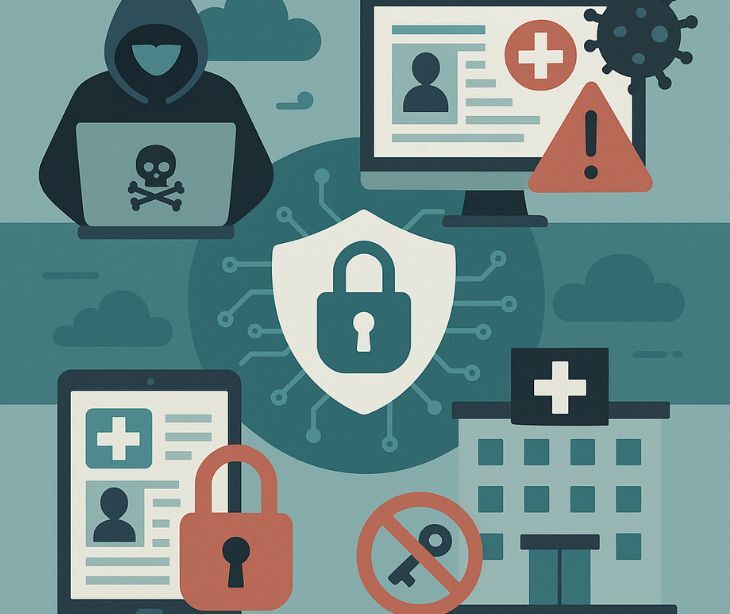
As Cybersecurity Threats in Healthcare IT: Challenges, Risks, and Mitigation Strategies explains, “Healthcare IT systems are a prime target for cybercriminals due to the sensitive nature of patient data and the critical role these systems play in patient care.” Therefore, policymakers, providers, and technology partners must understand these risks, their impacts, and possible solutions.
Ransomware and its impact on healthcare delivery
Ransomware is one of the most pressing cybersecurity challenges in healthcare. According to the study, “Ransomware attacks in healthcare are particularly devastating, leading to delays in care, compromised patient safety, and financial losses.” Such attacks threaten financial stability and patient outcomes, as evidenced in the WannaCry ransomware attack of 2017, which forced the UK’s National Health Service to cancel thousands of appointments and procedures.
The report notes, “Patient records, for example, could be locked and denied to both patient and doctor, leading to interference with medical delivery.” This illustrates the direct link between IT systems and patient safety. Ransomware creates situations in which hospitals are pressured to pay attackers quickly to restore access, given the critical nature of medical services.
Ultimately, the study recommends, “Full-scale backup regimes and post-incident response plans should be implemented to mitigate the impact of ransomware attacks.”
Accidental and intentional risks of insider threats
While external threats like ransomware attract a lot of attention, insider risks are equally concerning. The report states that insider threats in healthcare can be intentional, such as malicious data theft, or unintentional, such as accidental data leaks. Since healthcare staff need broad access to patient information, it is difficult to balance accessibility with security.
The report further explains, “Unintentional or deliberate loss of sensitive information is possible when staff with legal privilege to access patient details compromise the data.” Errors like sending information to incorrect recipients or mismanaging devices can expose sensitive records.
At the same time, disgruntled employees may intentionally misuse access. Therefore, we need to implement “strict access control measures, regular security sensitization, and monitoring devices to identify insiders accessing information abnormally [as] vital ways of mitigating insider threats in healthcare organizations.”
Security challenges in emerging technologies
Healthcare innovation includes the use of the Internet of Medical Things (IoMT), artificial intelligence, telemedicine, and blockchain. So, while these technologies can improve patient care, they can also expand the attack surface.
For example, IoMT devices can monitor and assist patients, yet “often run on outdated software or lack stringent security features and can be exploited to gain unlawful access to a hospital’s network or even manipulate patient care.” Insulin pumps, implantable cardiac devices, and infusion pumps have also been cited as vulnerable.
Artificial intelligence also introduces risk. According to the study, “It is common for AI systems in healthcare to rely on vast databases of patients’ data, which can be seen as a privacy invasion or potential for adversarial attacks to influence the procedure of AI decision-making.” This raises the possibility of corrupted or manipulated datasets affecting clinical diagnoses and treatment recommendations.
Blockchain, too, is a mixed development, where it “could revolutionize health information exchange by providing a traceable and immutable record of data transactions… However, blockchain application in healthcare also raises important questions of scalability, privacy, and legal concerns.”
The human factor in cybersecurity
The human element is a major concern in healthcare cybersecurity. The study points out, “In healthcare cybersecurity, the human element is still a central weak spot". Since staff’s “primary attention is on the patients, healthcare workers might not always put cybersecurity first.” Physicians, nurses, and staff are trained to prioritize clinical decisions, and not necessarily cybersecurity protocols.
Furthermore, “The COVID-19 pandemic and other recent events have hastened the shift toward remote work and telemedicine, increasing the attack surface for healthcare institutions.”
Therefore, mitigating these risks also requires a company culture change. Healthcare organizations must create “a cybersecurity awareness culture. This encompasses insisting on firmwide compulsory, position-sensitive information security training for all personnel.”
In practice, organizations must integrate cybersecurity awareness into their daily operations. For example, staff training sessions, regular phishing simulations, and clear reporting channels for suspicious activity must be as routine as clinical hand-washing protocols.
Consequently, incorporating cybersecurity measures protects the electronic health records (EHRs) and connected devices as part of every professional’s duty of care. Normalizing these practices helps healthcare organizations create a culture where digital vigilance is inseparable from patient safety and clinical excellence.
How HIPAA compliance improves cybersecurity
HIPAA establishes national standards for protecting patient health information, but compliance alone does not equate to comprehensive security. Technology changes rapidly, while regulations evolve slowly, creating gaps in protection.
As the research informs, “Healthcare firms have even more significant challenges in this regard, linked to fluctuating regulatory demands and new technologies that simultaneously make it challenging to guarantee robust protection against cyber threats and compliance.”
Therefore, healthcare organizations must go beyond compliance checklists and improve their proactive security strategies. Even the Food and Drug Administration’s device-focused guidelines acknowledge that secure consumer electronics products can be “vulnerable to cyber risks if these risks are continuously escalating.”
The costs of cyber incidents
Not all providers adhere consistently to HIPAA policies. According to an Informed Clinical Informatics study on Information Security Awareness and Behaviors of Health Care Professionals at Public Health Care Facilities, only 63% of healthcare workers reported being informed of their organization’s security policies, while 65% knew the proper procedures for handling and discarding confidential patient records.
Although 74% of respondents reported actively safeguarding PHI from unauthorized access, the overall numbers suggest that many providers are either neglecting or inadequately following HIPAA requirements, creating vulnerabilities that could expose patient information to data breaches and result in regulatory violations.
The first research study also shows an increase in attacks over recent years, where data breaches escalated from 642 in the year 2020 to 978 in the year 2024. In contrast, ransomware attacks rose from 92 to 342 in 2024. These numbers show the prevalence of incidents as well as their growing sophistication.
The financial implications of cybersecurity show “a projected $1.2 billion in 2020 and $3.75 billion in 2024.” These costs encompass regulatory penalties, ransom payments, reputational damage, and the disruption of clinical services.
In addition, indirect costs like patient trust erosion, extended system downtime, and reduced staff productivity compound the financial burden. When combined, these direct and indirect consequences show how inadequate cybersecurity measures threaten organizational resilience and the overall sustainability of healthcare delivery.
Learn more: The complete guide to HIPAA violations
Strategies for a more secure future
The first study shows that cybersecurity solutions require technical and organizational measures. More specifically, healthcare organizations must implement a multi-layered security approach that integrates technical, administrative, and physical safeguards. Such measures include encryption, multi-factor authentication, and secure data transmission.
It also suggests that organizations incorporate modern systems into their networks to track user activity, system and network event logs, and traffic. These monitoring tools will help organizations detect anomalies early and respond before threats escalate.
Furthermore, "to address the cybersecurity challenges in healthcare IT firms, they need to establish the Zero Trust Architecture. This strategy mandates that the principle 'never trust, always verify' be applied to all network end users through multi-factor authentication…” restricting access at every stage, reducing opportunities for attackers.
Finally, collaboration across the sector is emphasized, “Healthcare providers should actively participate in threat intelligence sharing initiatives that are relevant to the healthcare sector, become involved in the development of future rounds of regulation, collaborate with academic institutions that have expertise in cutting-edge research, and share knowledge with other healthcare providers.”
FAQs
Who does HIPAA apply to?
HIPAA applies to covered entities, which include healthcare providers, health plans, and healthcare clearinghouses. It also applies to business associates of these covered entities. These are entities that perform certain functions or activities on behalf of the covered entity.
What is a ransomware attack?
Ransomware attacks are a type of cyberattack where hackers gain unauthorized access to a computer, encrypt its data, and demand the return of this data upon payment.
Hackers often target sensitive information like personal, financial, or healthcare data, crippling their operations until the ransom is paid or recovered by other means.
Ransomware typically spreads through phishing emails, malicious links, or software vulnerabilities, exploiting weak cybersecurity defenses. Even after paying the ransom, victims are not guaranteed data recovery.
Why is the healthcare sector a major target of ransomware attacks?
Healthcare facilities handle individuals’ sensitive personal and medical data and operate with minimal downtime, making them attractive targets for cybercriminals.



%20(5)-1.jpg)
